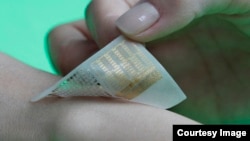Wearable sensor devices that look like a stretchable bandage may soon be available to monitor and treat individuals with certain diseases. Researchers are first targeting muscle disorders, but wearable electronics may eventually be designed for other health conditions.
The wearable health monitoring device, developed by Korean engineers and described in Nature Nanotechnology, looks like a small adhesive bandage with grids of shiny nanowires and other materials on the bottom, closest to the skin.
The prototype monitor can be worn on the wrist, continuously gathering and storing physiological activity for up to one week. Medications embedded in a silica interface within the flexible electronic device would be administered as necessary.
Researchers envision using the flexible monitor initially to treat people with Parkinson’s disease or epilepsy.
“After monitoring the abnormal muscle movement of the patient, we can ... analyze patterns stored in the memory to analyze the condition of [the] patient," said Dae-Hyeong Kim, professor of biological and chemical engineering at Seoul National University. "And depending on the condition of the patient, we can control the delivery amount of the embedded drug.”
Kim says current wearable health monitors provide accurate information but are bulky. The sensor-laden electronic device his team created would be seamlessly integrated with the skin.
In time, Kim says flexible monitors could be designed to keep track of the activity of internal organs, including the heart and brain. Another device could monitor blood glucose levels and infuse insulin automatically.
The first experimental monitor, designed to keep track of muscle movements, was successfully tested on pig skin. Kim says he would like to pack other capabilities into the health monitor.
“Like wireless power transmission or wireless data transmission, which can communicate with smart phones and deliver data from the patient side to the hospital,” he said.
But before the stretchable monitoring device is ready for human use, Kim says a number of engineering challenges must be overcome, including regulating drug delivery to patients.
The wearable health monitoring device, developed by Korean engineers and described in Nature Nanotechnology, looks like a small adhesive bandage with grids of shiny nanowires and other materials on the bottom, closest to the skin.
The prototype monitor can be worn on the wrist, continuously gathering and storing physiological activity for up to one week. Medications embedded in a silica interface within the flexible electronic device would be administered as necessary.
Researchers envision using the flexible monitor initially to treat people with Parkinson’s disease or epilepsy.
“After monitoring the abnormal muscle movement of the patient, we can ... analyze patterns stored in the memory to analyze the condition of [the] patient," said Dae-Hyeong Kim, professor of biological and chemical engineering at Seoul National University. "And depending on the condition of the patient, we can control the delivery amount of the embedded drug.”
Kim says current wearable health monitors provide accurate information but are bulky. The sensor-laden electronic device his team created would be seamlessly integrated with the skin.
In time, Kim says flexible monitors could be designed to keep track of the activity of internal organs, including the heart and brain. Another device could monitor blood glucose levels and infuse insulin automatically.
The first experimental monitor, designed to keep track of muscle movements, was successfully tested on pig skin. Kim says he would like to pack other capabilities into the health monitor.
“Like wireless power transmission or wireless data transmission, which can communicate with smart phones and deliver data from the patient side to the hospital,” he said.
But before the stretchable monitoring device is ready for human use, Kim says a number of engineering challenges must be overcome, including regulating drug delivery to patients.







